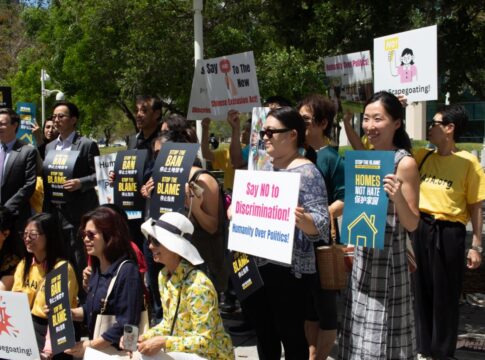
By Felix Poon, AsAmNews Intern
Asian Americans, Native Hawaiians and Pacific Islanders (AA/NHPI) make up nearly 6% of the national US population. But clinical research on the group funded by the National Institutes of Health (NIH) made up only 0.17% of their total budget from 1992 to 2018, according to Lan Doan, a doctoral candidate in public health at Oregon State University. Doan published her research in the JAMA Network Open article, Trends in Clinical Research Including Asian American, Native Hawaiian, and Pacific Islander Participants Funded by the US National Institutes of Health, 1992 to 2018.
Doan reviewed publicly available abstracts between 1992 and 2018, and found 529 clinical research studies that explicitly included AA, NHPI, or specific ethnic subgroups in the abstract text. Doan calculated the proportion of research funding by obtaining expenditures from the NIH Office of Budget for fiscal years 1992 to 2018.
“Our review of the last two decades found that no real progress has been made,” Doan said in an interview with AsAmNews.
“Looking at all of the studies, we also found that less than 60% mentioned a specific Asian American, Native Hawaiian, or Pacific Islander subgroup. So if we’re looking at data disaggregation, less than 60% of the studies talked about a specific group.”
LATEST STORIES
Data disaggregation is the breaking out of a general racial category into specific ethnic groups. Doan said that disaggregating data is important because Asians are typically lumped together in research, and doing so masks health disparities that exist within specific subgroups. “For example, in aggregate, AA/NHPI adult rates of liver cancer incidence and mortality are double those of non-Hispanic White adults,” Doan’s research article reads.
“However, when data are disaggregated, liver cancer incidence is 7 times higher and 9 times higher for Laotian men and women, respectively, compared with non-Hispanic White adults. Understanding the complexities of health by subgroup could be the difference between eliminating or worsening health disparities.”
The lack of good public health data can leave service providers scrambling to make up for it. That’s the case for Sherry Dong, the director of community health improvement programs at Tufts Medical Center in Boston, including the Asian Health Initiative (AHI), which was established in 1995. “Our goal was and continues to be to identify and address public health needs of particular concern and problems in the Chinatown and local Asian community, in partnership with the community, and in a culturally and linguistically appropriate and sensitive manner,” Dong told AsAmNews.
“Because of the precarious state of public health data, we tend to rely more heavily on qualitative information such as speaking with key informant interviews, having stakeholder focus groups, and surveys that we fan out into the community that are in multiple languages…. I’ve also accessed our interpreter services department to ask them, what are the top languages that they serve, to give me some sense of who are we seeing?”
When it comes to getting disaggregated data, Dong said their process is more art than it is science. “There is a large Chinese community in Chinatown, and in some other neighborhoods, like Allston and Brighton, for example. And in Dorchester there’s a large Vietnamese population. So if we had neighborhood specific data, but not disaggregated Asian data, we could draw some conclusions if we saw Asian data in a particular neighborhood that it might more likely be…this group than that. And that is more because we know where they live.”
Dong would like to see more funding for translation of surveys into multiple Asian languages, as well as multilingual and literate staff at government health agencies in order to promote inclusion in data collection processes.
Doan also pointed to the importance of diversity in the work force, including the diversity of review panels, investigators, and training programs and research projects. “Although my research focused on funding for a specific racial ethnic group, it’s important to constantly be reevaluating where the priorities and investments are in order to do better and eliminate health disparities,” Doan said.
The NIH issued a statement in response to AsAmNews’ request for comment.
NIH funding spans all categories of diseases and conditions across all populations. Importantly, NIH’s policy is to ensure the appropriate representation of underrepresented groups in clinical research: grants.nih.gov/policy/inclusion/women-and-minorities.htm. Since disease affects all populations, representation in clinical trials helps ensure that the effects of treatments are known for all populations. In FY 2018 (NIH’s last full fiscal year), the proportion of participants in NIH-funded clinical research by race was 9% Asian, 0.2% Native Hawaiian or Pacific Islander, 1% American Indian or Alaska Native,16% Black or African American, 58.5% White, and 2.8% More than One Race (12.4% of participants did not report race). Nine percent of participants identified as Hispanic. Additionally, the National Institute on Minority Health and Health Disparities is focused on research to reduce disparities in health status and health care delivery, including racial and ethnic minority groups, rural populations, populations with low socioeconomic status, and other population groups. Their budget isn’t specific to types of populations but rather to the problem of disparities broadly.
As a point of clarity, Doan’s research looked for studies that specifically focus on AA/NHPI populations, and found them in 0.17% of NIH funding. The NIH statement cites a different figure—out of all NIH-funded clinical research participants in 2018, 9% identified as Asian and 0.2% identified as Native Hawaiian or Pacific Islander. Both figures are valid, but Doan pointed to potential downsides of the latter—the data is not disaggregated, for example; Doan questions whether results are generalizable to “health disparities populations” who “might require different recruitment strategies, [and] language appropriate interventions;” finally Doan questions whether enough Asian or NHPI participants were recruited in these studies to conduct statistical analyses to test hypotheses about health outcomes specifically for Asians and NHPI.
Doan declined to prescribe what percentage of research money she thinks the NIH should allocate. “I can’t say that X percentage of research money will eliminate disparities in AA and NHPI communities,” she said.
“Everyone wants an exact percent or specific solution, but regardless of what it is, we collectively need to do better.”
AsAmNews has Asian America in its heart. We’re an all-volunteer effort of dedicated staff and interns. Check out our Twitter feed and Facebook page for more content. Please consider interning, joining our staff or submitting a story.








